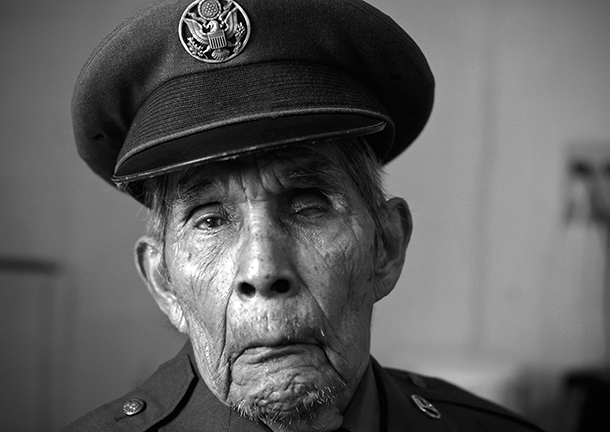
Valentina Sireech, Portrait of Lawrence, The Last Ute Warrior documentary series
Valentina Sireech
Northern Ute
Date
2008
Medium Specific
Digital print
Classification
Photograph
Dimensions
15 1/4 x 22 1/2 in. (38.7 x 57.2 cm.), Framed: 23 1/4 x 31 in. (59.1 x 78.7 cm.)
Accession Number
2022.20.10.25
Credit
Gift of the Artist
Memo / Artist Statement
As an artist and photographer, I had spent a year working photographically alongside a Ute elder who recalls his escape from the Baatan Death March camp 66 years after WWII. Lawrence Tom is one of five Native American U.S. veterans still alive who survived the Baatan Death March in the Philippines during World War II.
The march, involving the forcible transfer of 75,000 American and Filipino prisoners of war captured by the Japanese in the Philippines from the Bataan peninsula to prison camps, was characterized by wide-ranging physical abuse and murder, and resulted in very high fatalities inflicted upon the prisoners and civilians along the route by the armed forces of the Empire of Japan. Beheadings, cut throats and casual shootings were the more common and merciful actions — compared to bayonet stabbings, rapes, disembowelments, numerous rifle butt beatings and a deliberate refusal to allow the prisoners food or water while keeping them continually marching for nearly a week (for the slowest survivors) in tropical heat. Falling down, unable to continue moving was tantamount to a death sentence, as was any degree of protest or expression of displeasure and was later accounted as a Japanese war crime.
Working closely with Lawrence Tom, 86, (now blind and reliant on his younger brother for his shelter and care) was the key role in developing this documentary essay that reflects his valor that exemplified the Native American warriors, who have always been proportionally among the highest number of Americans to fight in any war, is evidence of selflessness as a value in Native cultures and now forgotten in today’s social structures.
It should be noted that in many times of need around the world our noble men and women have fought ably to secure the freedoms of other peoples, to release other human beings from brutal tyrants and oppressive systems and to protect the sovereignty of other nations of Europe, Asia, and elsewhere. What about his own sovereignty? Did Lawrence’s valor of courage go over looked by the U. S Government and our own community?
“The Last Ute Warrior” is a large body of photographic work that explores a human and social structure of a post-war Native American veteran.
The march, involving the forcible transfer of 75,000 American and Filipino prisoners of war captured by the Japanese in the Philippines from the Bataan peninsula to prison camps, was characterized by wide-ranging physical abuse and murder, and resulted in very high fatalities inflicted upon the prisoners and civilians along the route by the armed forces of the Empire of Japan. Beheadings, cut throats and casual shootings were the more common and merciful actions — compared to bayonet stabbings, rapes, disembowelments, numerous rifle butt beatings and a deliberate refusal to allow the prisoners food or water while keeping them continually marching for nearly a week (for the slowest survivors) in tropical heat. Falling down, unable to continue moving was tantamount to a death sentence, as was any degree of protest or expression of displeasure and was later accounted as a Japanese war crime.
Working closely with Lawrence Tom, 86, (now blind and reliant on his younger brother for his shelter and care) was the key role in developing this documentary essay that reflects his valor that exemplified the Native American warriors, who have always been proportionally among the highest number of Americans to fight in any war, is evidence of selflessness as a value in Native cultures and now forgotten in today’s social structures.
It should be noted that in many times of need around the world our noble men and women have fought ably to secure the freedoms of other peoples, to release other human beings from brutal tyrants and oppressive systems and to protect the sovereignty of other nations of Europe, Asia, and elsewhere. What about his own sovereignty? Did Lawrence’s valor of courage go over looked by the U. S Government and our own community?
“The Last Ute Warrior” is a large body of photographic work that explores a human and social structure of a post-war Native American veteran.
Date of Bio
